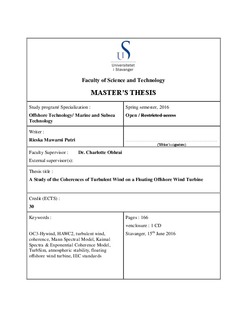| dc.contributor.advisor | Obhrai, Charlotte | |
| dc.contributor.author | Putri, Rieska Mawarni | |
| dc.date.accessioned | 2016-09-28T13:29:07Z | |
| dc.date.available | 2016-09-28T13:29:07Z | |
| dc.date.issued | 2016-06 | |
| dc.identifier.uri | http://hdl.handle.net/11250/2411463 | |
| dc.description | Master's thesis in Offshore technology: Marine and subsea technology | nb_NO |
| dc.description.abstract | In the development of offshore wind turbine industry, the shift from the use of fixed-substructure wind turbines to the floating wind turbines is expected to maximise the offshore wind power extraction while reducing construction cost and enhancing the structural reliability, particularly in deep waters. Up to the present time, the available floating wind turbine concepts are adopted from the offshore oil and gas industry experiences, namely semi-submersible, tensioned-leg platform (TLP), and deep draft floater (spar). Especially for the latter type (spar), by combining this platform with large turbine rotors, studies had shown that they are susceptible in terms of platform motions when exposed to a turbulent wind. It was hypothesised that the spatial correlation of the occurring turbulence (lateral and vertical coherences) at different points on the floating wind turbine rotor influences the floater motions. The unstable atmospheric stability conditions which occur more frequently offshore, has been hypothesised to cause severe fatigue damages on the wind turbine components. The two recommended models given in the IEC standards to estimate the spatial correlation of the turbulent wind: the Mann Spectral Tensor Model and the Kaimal Spectra & Exponential Coherence Model predict very different coherences, in particular for larger separations. Moreover, the fact that one of the models is unable to capture the effects of varying atmospheric stability, results in the need to select the suitable model for wind turbine design.
This master thesis will investigate the comparison of the influences between the two turbulence models outlined in the IEC standards on a spar-buoy floating wind turbine—the OC3-Hywind—motions and fatigue loadings. The effects of the lateral and the vertical coherences from the synthetic (generated) wind fields from the two turbulence models and fitted-measurements parameter inputs on the OC3-Hywind turbine loadings and motion responses will be studied using HAWC2 aero-hydro-servo-elastic code. In addition, the influences of combined turbulence variation and mean wind profile under different atmospheric stability conditions on a spar-buoy floating wind turbine will also be studied.
In general, it was noted that the OC3-Hywind turbine was rather stiff in terms of yaw motion, but not for the pitch motion. It was found that the IEC Mann Spectral Tensor Model was more conservative when use to quantify damage equivalent loads and platform motions (pitch and yaw) on the OC3-Hywind turbine compared to the IEC Kaimal Spectra & Coherence Model. The given parameters from the IEC standards was found to be more conservative than the fitted-measurements parameters in predicting motions and damage equivalent loads of the OC3-Hywind. The mean wind profile under stable conditions was observed to affect the blade root fatigue damage by up to 5% only. It was also observed that a higher vertical coherence resulted in higher pitch motion of the OC3-Hywind. The influence of the lateral coherence on the OC3-Hywind turbine yaw motion was observed when comparing the coherences from the two IEC turbulent wind models, where lower lateral coherence resulted in higher platform yaw motion. When comparing the coherences from the fitted-measurements parameters, the influence of the lateral coherence on the OC3-Hywind yaw motion was less obvious, but the yaw motion was shown to be influenced by the turbulence levels which was correlated with the parameter αϵ^(2/3). Nonetheless, the results obtained were based on limited number of simulations, which should ideally be expanded in a more extensive parametric study. | nb_NO |
| dc.language.iso | eng | nb_NO |
| dc.publisher | University of Stavanger, Norway | nb_NO |
| dc.relation.ispartofseries | Masteroppgave/UIS-TN-IKM/2016; | |
| dc.rights | Navngivelse 3.0 Norge | * |
| dc.rights.uri | http://creativecommons.org/licenses/by/3.0/no/ | * |
| dc.subject | HAWC2 | nb_NO |
| dc.subject | turbulent wind | nb_NO |
| dc.subject | lateral coherence | nb_NO |
| dc.subject | vertical coherence | nb_NO |
| dc.subject | offshore teknologi | nb_NO |
| dc.subject | Mann spectral tensor model | nb_NO |
| dc.subject | Kaimal spectra and exponential coherence model | nb_NO |
| dc.subject | marin og undervannsteknologi | nb_NO |
| dc.subject | subsea technology | nb_NO |
| dc.title | A Study of the Coherences of Turbulent Wind on a Floating Offshore Wind Turbine | nb_NO |
| dc.type | Master thesis | nb_NO |
| dc.subject.nsi | VDP::Technology: 500::Marine technology: 580::Offshore technology: 581 | nb_NO |

